Rockfall Intensity under Seismic and Aseismic Conditions: The Case of Lefkada Island, Greece
Abstract
1. Introduction
2. Materials and Methods
2.1. Study Area
2.1.1. Engineering Geology and Earthquakes
2.1.2. The Earthquake of 14 August 2003
2.1.3. The Earthquake of 17 November 2015
2.2. Applied Methodology
2.2.1. Rock Mass Characteristics
2.2.2. Rockfall Inventory
2.2.3. Rockfall Simulation
2.2.4. Rockfall Intensity
Theoretical Framework of Rockfall Kinetic Energy
3. Results and Discussion
3.1. Determination of the Representative Rock Block Volume
3.2. Estimation of Rockfall Restitution Coefficients
3.3. Initial Rock Block Velocity
3.4. Rockfall Intensity in Aseismic and Seismic Conditions
4. Conclusions
Author Contributions
Funding
Institutional Review Board Statement
Informed Consent Statement
Data Availability Statement
Conflicts of Interest
References
- Varnes, D.J. Slope Movement Types and Processes. In Special Report 176: LAndslides: Analysis and Contro; Schuster, R.L., Krizek, R.J., Eds.; TRB, National Research Council: Washington, DC, USA, 1978; pp. 11–33. [Google Scholar]
- Ferrari, F.; Giacomini, A.; Thoeni, K. Qualitative Rockfall Hazard Assessment: A Comprehensive Review of Current Practices. Rock Mech. Rock Eng. 2016, 49, 2865–2922. [Google Scholar] [CrossRef]
- Lateltin, O.; Haemmig, C.; Raetzo, H.; Bonnard, C. Landslide Risk Management in Switzerland. Landslides 2005, 2, 313–320. [Google Scholar] [CrossRef]
- Ferrari, F.; Giacomini, A.; Thoeni, K.; Lambert, C. Qualitative Evolving Rockfall Hazard Assessment for Highwalls. Int. J. Rock Mech. Min. Sci. 2017, 98, 88–101. [Google Scholar] [CrossRef]
- Saroglou, H.; Marinos, V.; Marinos, P.; Tsiambaos, G. Rockfall Hazard and Risk Assessment: An Example from a High Promontory at the Historical Site of Monemvasia, Greece. Nat. Hazards Earth Syst. Sci. 2012, 12, 1823–1836. [Google Scholar] [CrossRef]
- Depountis, N.; Nikolakopoulos, K.; Kavoura, K.; Sabatakakis, N. Description of a GIS-Based Rockfall Hazard Assessment Methodology and Its Application in Mountainous Sites. Bull. Eng. Geol. Environ. 2020, 79, 645–658. [Google Scholar] [CrossRef]
- Asteriou, P.; Saroglou, H.; Tsiambaos, G. Geotechnical and Kinematic Parameters Affecting the Coefficients of Restitution for Rock Fall Analysis. Int. J. Rock Mech. Min. Sci. 2012, 54, 103–113. [Google Scholar] [CrossRef]
- Ulamış, K.; Kılıç, R. Combined Instability Assessment and Rockfall Hazard in Volcanic Rocks (Keçiören, Ankara). Arab. J. Geosci. 2020, 13, 349. [Google Scholar] [CrossRef]
- Brabb, E.E. Innovative Approaches to Landslide Hazard Mapping. In Proceedings of the 4th International Symposium on Landslides, Toronto, ON, Canada, 16 September 1984; Volume 1, pp. 307–324. [Google Scholar]
- Fell, R.; Corominas, J.; Bonnard, C.; Cascini, L.; Leroi, E.; Savage, W.Z. Guidelines for Landslide Susceptibility, Hazard and Risk Zoning for Land-Use Planning. Eng. Geol. 2008, 102, 99–111. [Google Scholar] [CrossRef]
- Antoniou, A.A.; Lekkas, E. Rockfall Susceptibility Map for Athinios Port, Santorini Island, Greece. Geomorphology 2010, 118, 152–166. [Google Scholar] [CrossRef]
- Papathanassiou, G.; Pavlides, S.; Ganas, A. The 2003 Lefkada Earthquake: Field Observations and Preliminary Microzonation Map Based on Liquefaction Potential Index for the Town of Lefkada. Eng. Geol. 2005, 82, 12–31. [Google Scholar] [CrossRef]
- Zekkos, D.; Clark, M.; Cowell, K.; Medwedeff, W.; Manousakis, J.; Saroglou, H.; Tsiambaos, G. Satellite and UAV-Enabled Mapping of Landslides Caused by the November 17th 2015 Mw 6.5 Lefkada Earthquake. In Proceedings of the 19th International Conference on Soil Mechanics and Geotechnical Engineering, Seoul, Republic of Korea, 17–21 September 2017; pp. 2235–2238. [Google Scholar]
- Tsangaratos, P.; Loupasakis, C.; Nikolakopoulos, K.; Angelitsa, V.; Ilia, I. Developing a Landslide Susceptibility Map Based on Remote Sensing, Fuzzy Logic and Expert Knowledge of the Island of Lefkada, Greece. Environ. Earth Sci. 2018, 77, 363. [Google Scholar] [CrossRef]
- Papathanassiou, G.; Valkaniotis, S.; Ganas, A.; Pavlides, S. GIS-Based Statistical Analysis of the Spatial Distribution of Earthquake-Induced Landslides in the Island of Lefkada, Ionian Islands, Greece. Landslides 2013, 10, 771–783. [Google Scholar] [CrossRef]
- Polykretis, C.; Kalogeropoulos, K.; Andreopoulos, P.; Faka, A.; Tsatsaris, A.; Chalkias, C. Comparison of Statistical Analysis Models for Susceptibility Assessment of Earthquake-Triggered Landslides: A Case Study from 2015 Earthquake in Lefkada Island. Geosciences 2019, 9, 350. [Google Scholar] [CrossRef]
- Keefer, D.K. Rock Avalanches Caused by Earthquakes: Source Characteristics. Science 1984, 223, 1288–1290. [Google Scholar] [CrossRef] [PubMed]
- Saroglou, C. GIS-Based Rockfall Susceptibility Zoning in Greece. Geosciences 2019, 9, 163. [Google Scholar] [CrossRef]
- Koukouvelas, I. Geology of Greece; Liberal Books: Athens, Greece, 2019; ISBN 978-618-5012-40-3. [Google Scholar]
- Bornovas, J.; Rontogianni-Tsiabaou, T. Geological Map of Greece; Institute of Geology and Mineral Exploration: Athens, Greece, 1983. [Google Scholar]
- Cushing, E.M. Structural Evolution of the Greek Northwestern Margin on the Island of Lefkas and Its Surroundings (Northwestern Greece). Ph.D. Thesis, Université de Paris-Sud, Orsay, France, 1985. [Google Scholar]
- Lekkas, E.; Danamos, G.D.; Lozios, S.G. Neotectonic Structure and Evolution of Lefkada Island. Bull. Geol. Soc. Greece 2001, 34, 157–163. [Google Scholar] [CrossRef]
- Rondoyanni, T.; Sakellariou, M.; Baskoutas, J.; Christodoulou, N. Evaluation of Active Faulting and Earthquake Secondary Effects in Lefkada Island, Ionian Sea, Greece: An Overview. Nat. Hazards 2012, 61, 843–860. [Google Scholar] [CrossRef]
- Saroglou, C.; Asteriou, P.; Zekkos, D.; Tsiambaos, G.; Clark, M.; Manousakis, J. UAV-Based Mapping, Back Analysis and Trajectory Modeling of a Coseismic Rockfall in Lefkada Island, Greece. Nat. Hazards Earth Syst. Sci. 2018, 18, 321–333. [Google Scholar] [CrossRef]
- Grendas, N.; Marinos, V.; Papathanassiou, G.; Ganas, A.; Valkaniotis, S. Engineering Geological Mapping of Earthquake-Induced Landslides in South Lefkada Island, Greece: Evaluation of the Type and Characteristics of the Slope Failures. Environ. Earth Sci. 2018, 77, 425. [Google Scholar] [CrossRef]
- Valkaniotis, S.; Papathanassiou, G.; Ganas, A. Mapping an Earthquake-Induced Landslide Based on UAV Imagery; Case Study of the 2015 Okeanos Landslide, Lefkada, Greece. Eng. Geol. 2018, 245, 141–152. [Google Scholar] [CrossRef]
- Karakostas, V.G. Properties of the 2003 Lefkada, Ionian Islands, Greece, Earthquake Seismic Sequence and Seismicity Triggering. Bull. Seismol. Soc. Am. 2004, 94, 1976–1981. [Google Scholar] [CrossRef]
- Zahradnik, J.; Serpetsidaki, A.; Sokos, E.; Tselentis, G.-A. Iterative Deconvolution of Regional Waveforms and a Double-Event Interpretation of the 2003 Lefkada Earthquake, Greece. Bull. Seismol. Soc. Am. 2005, 95, 159–172. [Google Scholar] [CrossRef]
- Louvari, E.; Kiratzi, A.A.; Papazachos, B.C. The Cephalonia Transform Fault and Its Extension to Western Lefkada Island (Greece). Tectonophysics 1999, 308, 223–236. [Google Scholar] [CrossRef]
- Scordilis, E.M.; Karakaisis, G.F.; Karacostas, B.G.; Panagiotopoulos, D.G.; Comninakis, P.E.; Papazachos, B.C. Evidence for Transform Faulting in the Ionian Sea: The Cephalonia Island Earthquake Sequence of 1983. Pure Appl. Geophys. 1985, 123, 388–397. [Google Scholar] [CrossRef]
- Benetatos, C.; Kiratzi, A.; Roumelioti, Z.; Stavrakakis, G.; Drakatos, G.; Latoussakis, I. The 14 August 2003 Lefkada Island (Greece) Earthquake: Focal Mechanisms of the Mainshock and of the Aftershock Sequence. J. Seismol. 2005, 9, 171–190. [Google Scholar] [CrossRef]
- Papadimitriou, P.; Kaviris, G.; Makropoulos, K. The MW=6.3 2003 Lefkada Earthquake (Greece) and Induced Stress Transfer Changes. Tectonophysics 2006, 423, 73–82. [Google Scholar] [CrossRef]
- Papadopoulos, G.A.; Karastathis, V.K.; Ganas, A.; Pavlides, S.; Fokaefs, A.; Orfanogiannaki, K. The Lefkada, Sea (Greece), Shock (Mw 6.2) of 14 August 2003: Evidence for the Characteristic Earthquake from Seismicity and Ground Failures. Earth Planets Space 2003, 55, 713–718. [Google Scholar] [CrossRef]
- Ganas, A.; Elias, P.; Bozionelos, G.; Papathanassiou, G.; Avallone, A.; Papastergios, A.; Valkaniotis, S.; Parcharidis, I.; Briole, P. Coseismic Deformation, Field Observations and Seismic Fault of the 17 November 2015 M = 6.5, Lefkada Island, Greece Earthquake. Tectonophysics 2016, 687, 210–222. [Google Scholar] [CrossRef]
- Sokos, E.; Zahradník, J.; Gallovič, F.; Serpetsidaki, A.; Plicka, V.; Kiratzi, A. Asperity Break after 12 Years: The MW 6.4 2015 Lefkada (Greece) Earthquake: The MW 6.4 2015 Lefkada earthquake. Geophys. Res. Lett. 2016, 43, 6137–6145. [Google Scholar] [CrossRef]
- Chousianitis, K.; Konca, A.O.; Tselentis, G.-A.; Papadopoulos, G.A.; Gianniou, M. Slip Model of the 17 November 2015 MW = 6.5 Lefkada Earthquake from the Joint Inversion of Geodetic and Seismic Data: Lefkada 2015 slip model. Geophys. Res. Lett. 2016, 43, 7973–7981. [Google Scholar] [CrossRef]
- Melgar, D.; Ganas, A.; Geng, J.; Liang, C.; Fielding, E.J.; Kassaras, I. Source Characteristics of the 2015 MW 6.5 Lefkada, Greece, Strike-Slip Earthquake: THE 2015 MW 6.5 LEFKADA EARTHQUAKE. J. Geophys. Res. Solid Earth 2017, 122, 2260–2273. [Google Scholar] [CrossRef]
- Papathanassiou, G.; Valkaniotis, S.; Ganas, A.; Grendas, N.; Kollia, E. The November 17th, 2015 Lefkada (Greece) Strike-Slip Earthquake: Field Mapping of Generated Failures and Assessment of Macroseismic Intensity ESI-07. Eng. Geol. 2017, 220, 13–30. [Google Scholar] [CrossRef]
- Schmitt, R.G.; Tanyas, H.; Jessee, M.A.N.; Zhu, J.; Biegel, K.M.; Allstadt, K.E.; Jibson, R.W.; Thompson, E.M.; Van Westen, C.J.; Sato, H.P.; et al. An Open Repository of Earthquake-Triggered Ground-Failure Inventories; U.S. Geological Survey: Washington, DC, USA, 2017. [Google Scholar] [CrossRef]
- Saltogianni, V.; Taymaz, T.; Yolsal-Çevikbilen, S.; Eken, T.; Moschas, F.; Stiros, S. Fault Model for the 2015 Leucas (Aegean Arc) Earthquake: Analysis Based on Seismological and Geodetic Observations. Bull. Seismol. Soc. Am. 2017, 107, 433–444. [Google Scholar] [CrossRef]
- Barton, N.R. International Society for Rock Mechanics Commission on Standardization of Laboratory and Field Tests—Suggested Methods for the Quantitative Description of Discontinuities in Rock Masses. Int. J. Rock Mech. Min. Sci. Geomech. 1978, 15, 319–368. [Google Scholar]
- Marinos, P.; Hoek, E. GSI–A Geologically Friendly Tool for Rock Mass Strength Estimation. In Proceedings of the GeoEng2000 Conference, Melbourne, Australia, 19–24 November 2000; pp. 1422–1442. [Google Scholar]
- Romana, M. New Adjustment Ratings for Application of Bieniawski Classification to Slopes. In Proceedings of the International Symposium on the Role of Rock Mechanics in Excavations for Mining and Civil Works, Zacatecas, Mexico, 2–4 September 1985; International Society of Rock Mechanics: Lisbon, Portugal, 1985; pp. 49–53. [Google Scholar]
- Romana, M. The Geomechanical Classification SMR for Slope Correction. In Proceedings of the 8th ISRM Congress on Rock Mechanics, Tokyo, Japan, 25 September 1995; Volume 3, pp. 1085–1092. [Google Scholar]
- Mavrouli, O.; Corominas, J. Evaluation of Maximum Rockfall Dimensions Based on Probabilistic Assessment of the Penetration of the Sliding Planes into the Slope. Rock Mech. Rock Eng. 2020, 53, 2301–2312. [Google Scholar] [CrossRef]
- Palmstrom, A. The Volumetric Joint Count—A Useful and Simple Measure of the Degree of Rock Mass Jointing; New Delhi, India, 1982; pp. 221–228.
- Palmstrom, A. Application of the Volumetric Joint Count as a Measure of Rock Mass Jointing. In Proceedings of the International Symposium on Fundamentals of Rock Joints, Bjorkliden, Sweden, 15–20 September 1985; pp. 103–110. [Google Scholar]
- Palmstrom, A. The Volumetric Joint Count as a Measure of Rock Mass Jointing. In Proceedings of the F3 (fragmentation, form and flow in fractured media) Conference, Jerusalem, Israel, 6–9 January 1986; pp. 1–18. [Google Scholar]
- Morelli, G.L. Empirical Assessment of the Mean Block Volume of Rock Masses Intersected by Four Joint Sets. Rock Mech. Rock Eng. 2016, 49, 1759–1771. [Google Scholar] [CrossRef]
- Mavrouli, O.; Corominas, J.; Jaboyedoff, M. Size Distribution for Potentially Unstable Rock Masses and In Situ Rock Blocks Using LIDAR-Generated Digital Elevation Models. Rock Mech. Rock Eng. 2015, 48, 1589–1604. [Google Scholar] [CrossRef]
- Brunetti, M.T.; Guzzetti, F.; Rossi, M. Probability Distributions of Landslide Volumes. Nonlinear Process. Geophys. 2009, 16, 179–188. [Google Scholar] [CrossRef]
- Guzzetti, F.; Reichenbach, P.; Wieczorek, G.F. Rockfall Hazard and Risk Assessment in the Yosemite Valley, CA, USA. Nat. Hazards Earth Syst. Sci. 2003, 3, 491–503. [Google Scholar] [CrossRef]
- Laboratory of Engineering Geology, University of Patras Landslide. Management System of Western Greece. Available online: http://landslide.engeolab.gr/admin/ (accessed on 10 December 2022).
- Agliardi, F.; Crosta, G.B. High Resolution Three-Dimensional Numerical Modelling of Rockfalls. Int. J. Rock Mech. Min. Sci. 2003, 40, 455–471. [Google Scholar] [CrossRef]
- Guzzetti, F.; Crosta, G.; Detti, R.; Agliardi, F. STONE: A Computer Program for the Three-Dimensional Simulation of Rock-Falls. Comput. Geosci. 2002, 28, 1079–1093. [Google Scholar] [CrossRef]
- Guzzetti, F.; Reichenbach, P.; Ghigi, S. Rockfall Hazard and Risk Assessment Along a Transportation Corridor in the Nera Valley, Central Italy. Environ. Manag. 2004, 34, 191–208. [Google Scholar] [CrossRef]
- Skarlatoudis, A.A.; Papazachos, C.B.; Margaris, B.N.; Theodulidis, N.; Papaioannou, C.; Kalogeras, I.; Scordilis, E.M.; Karakostas, V. Erratum to Empirical Peak Ground-Motion Predictive Relations for Shallow Earthquakes in Greece. Bull. Seismol. Soc. Am. 2007, 97, 2219–2221. [Google Scholar] [CrossRef]
- Mavrouli, O.; Corominas, J.; Wartman, J. Methodology to Evaluate Rock Slope Stability under Seismic Conditions at Solà de Santa Coloma, Andorra. Nat. Hazards Earth Syst. Sci. 2009, 9, 1763–1773. [Google Scholar] [CrossRef]
- Sabatakakis, N.; Depountis, N.; Vagenas, N. Evaluation of Rockfall Restitution Coefficients. In Engineering Geology for Society and Territory—Volume 2; Lollino, G., Giordan, D., Crosta, G.B., Corominas, J., Azzam, R., Wasowski, J., Sciarra, N., Eds.; Springer International Publishing: Cham, Switzerland, 2015; pp. 2023–2026. ISBN 978-3-319-09056-6. [Google Scholar]
- Vagenas, N. Rockfall Simulation by Analytical Methods. Correlation of Rockfall Energy Dissipation Parameters and Rock Mass Characteristics. Ph.D. Thesis, University of Patras, Patras, Greece, 2020. [Google Scholar]
- ESRI. ArcGIS for Desktop Empirical Bayesian Kriging. Available online: https://desktop.arcgis.com/en/arcmap/10.3/guide-books/extensions/geostatistical-analyst/what-is-empirical-bayesian-kriging-.htm (accessed on 10 December 2022).
- He, Y.; Nie, L.; Lv, Y.; Wang, H.; Jiang, S.; Zhao, X. The Study of Rockfall Trajectory and Kinetic Energy Distribution Based on Numerical Simulations. Nat. Hazards 2021, 106, 213–233. [Google Scholar] [CrossRef]
- Keskin, İ.; Polat, A. Kinematic Analysis and Rockfall Assessment of Rock Slope at the UNESCO World Heritage City (Safranbolu/Turkey). Iran. J. Sci. Technol. Trans. Civ. Eng. 2022, 46, 367–384. [Google Scholar] [CrossRef]
- Barton, N.R.; Choubey, V. The Shear Strength of Rock Joints in Theory and Practice. Rock Mech. 1977, 10, 1–54. [Google Scholar] [CrossRef]
- Deere, D.U.; Miller, R.P. Engineering Classification and Index Properties for Intact Rock; Air Force Weapons Ltd. Kirtland Airforce Base: Albuquerque, NM, USA, 1966; p. 308, AFWL-TR-65-116. [Google Scholar]
- Zhang, G.; Tang, H.; Xiang, X.; Karakus, M.; Wu, J. Theoretical Study of Rockfall Impacts Based on Logistic Curves. Int. J. Rock Mech. Min. Sci. 2015, 78, 133–143. [Google Scholar] [CrossRef]
- Yu, B.; Yi, W.; Zhao, H. Experimental Study on the Maximum Impact Force by Rock Fall. Landslides 2018, 15, 233–242. [Google Scholar] [CrossRef]
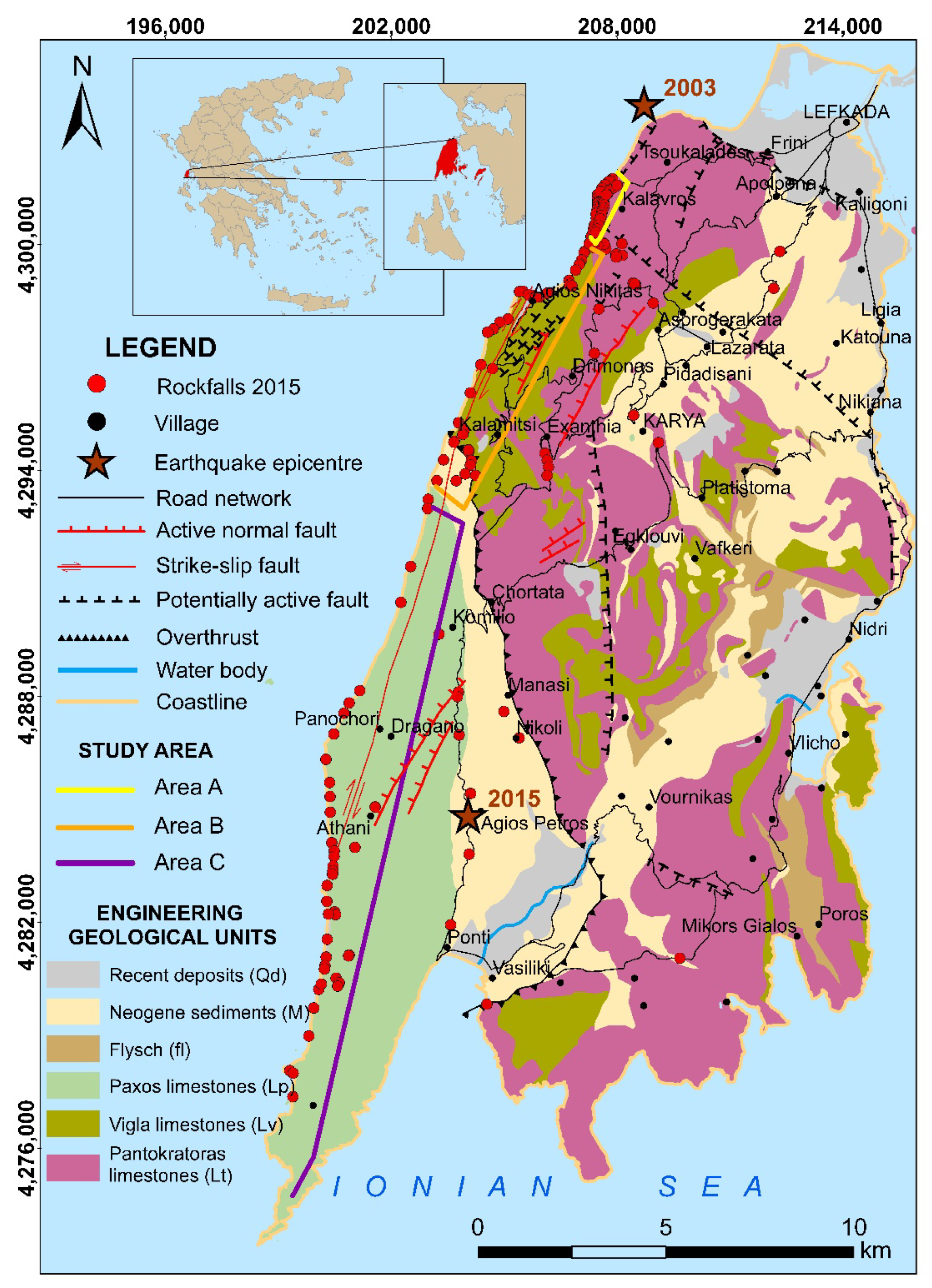
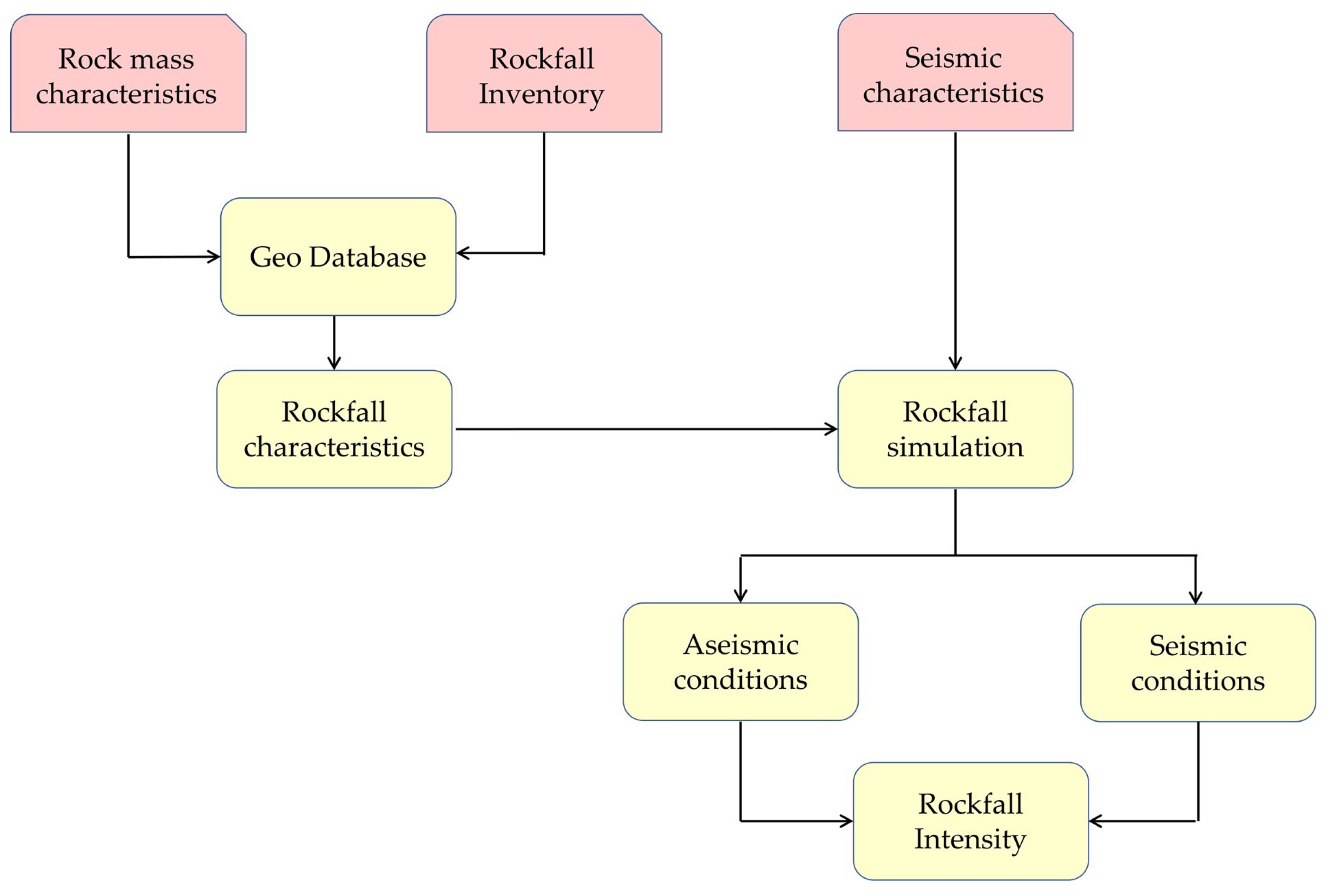
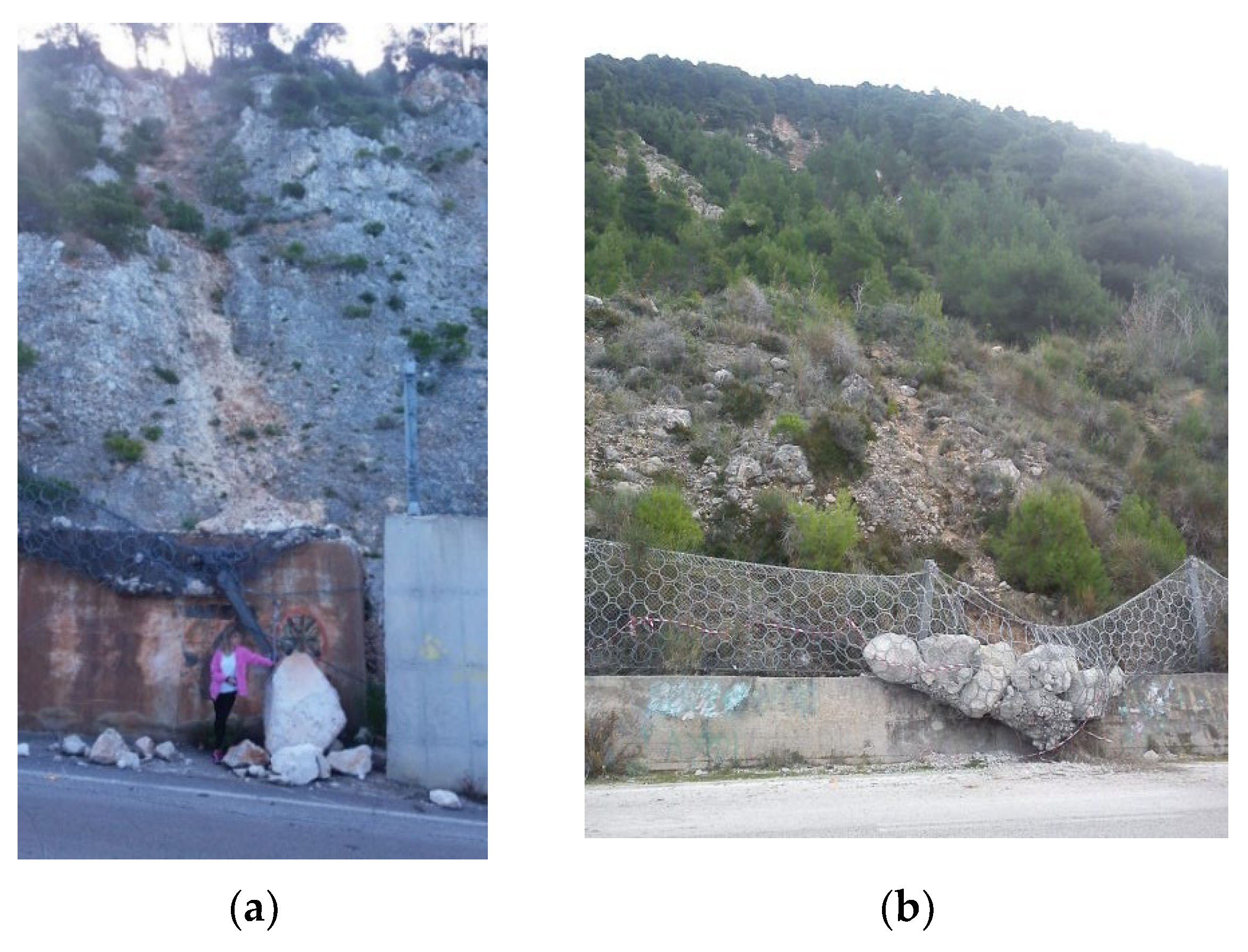
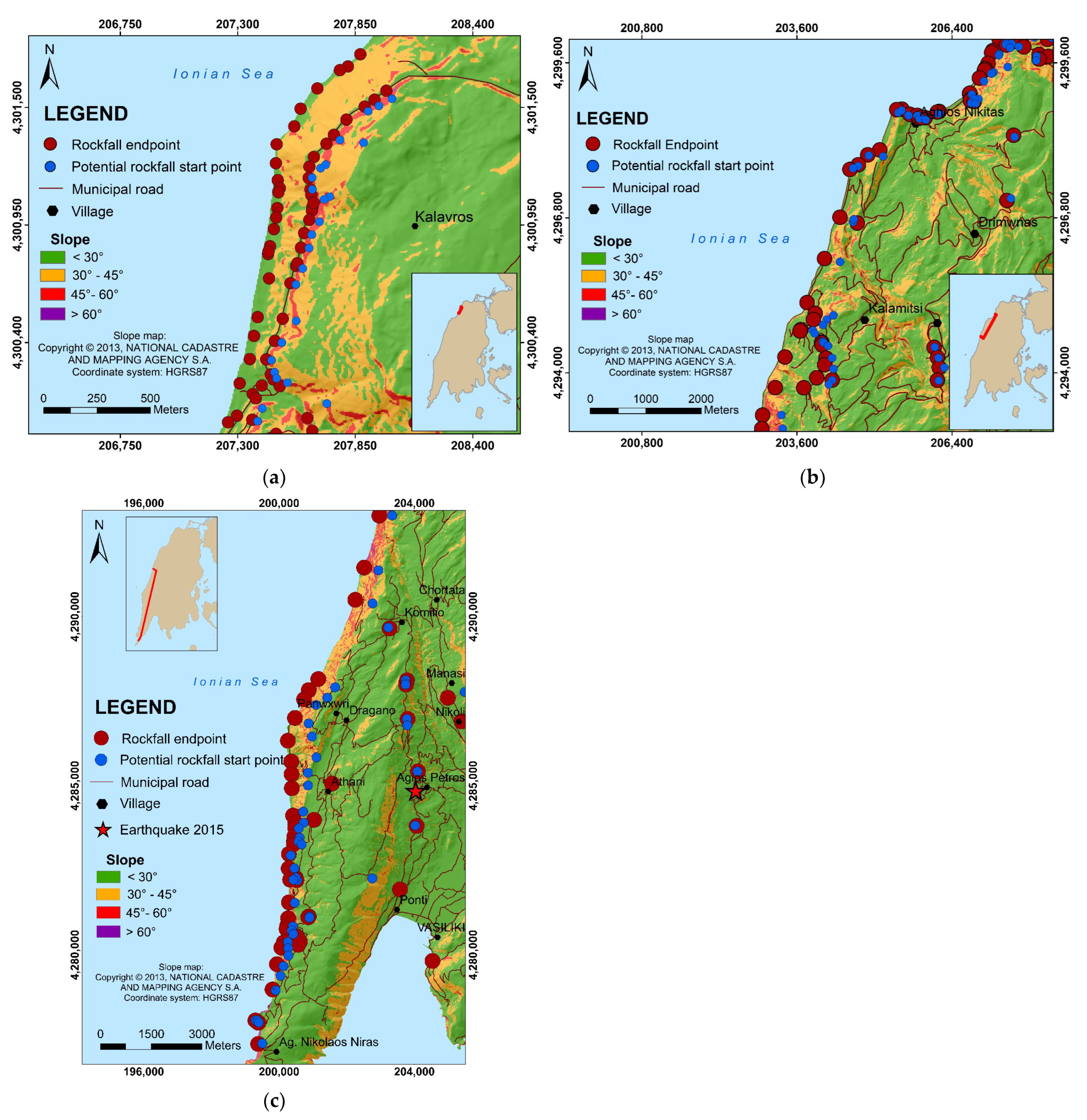
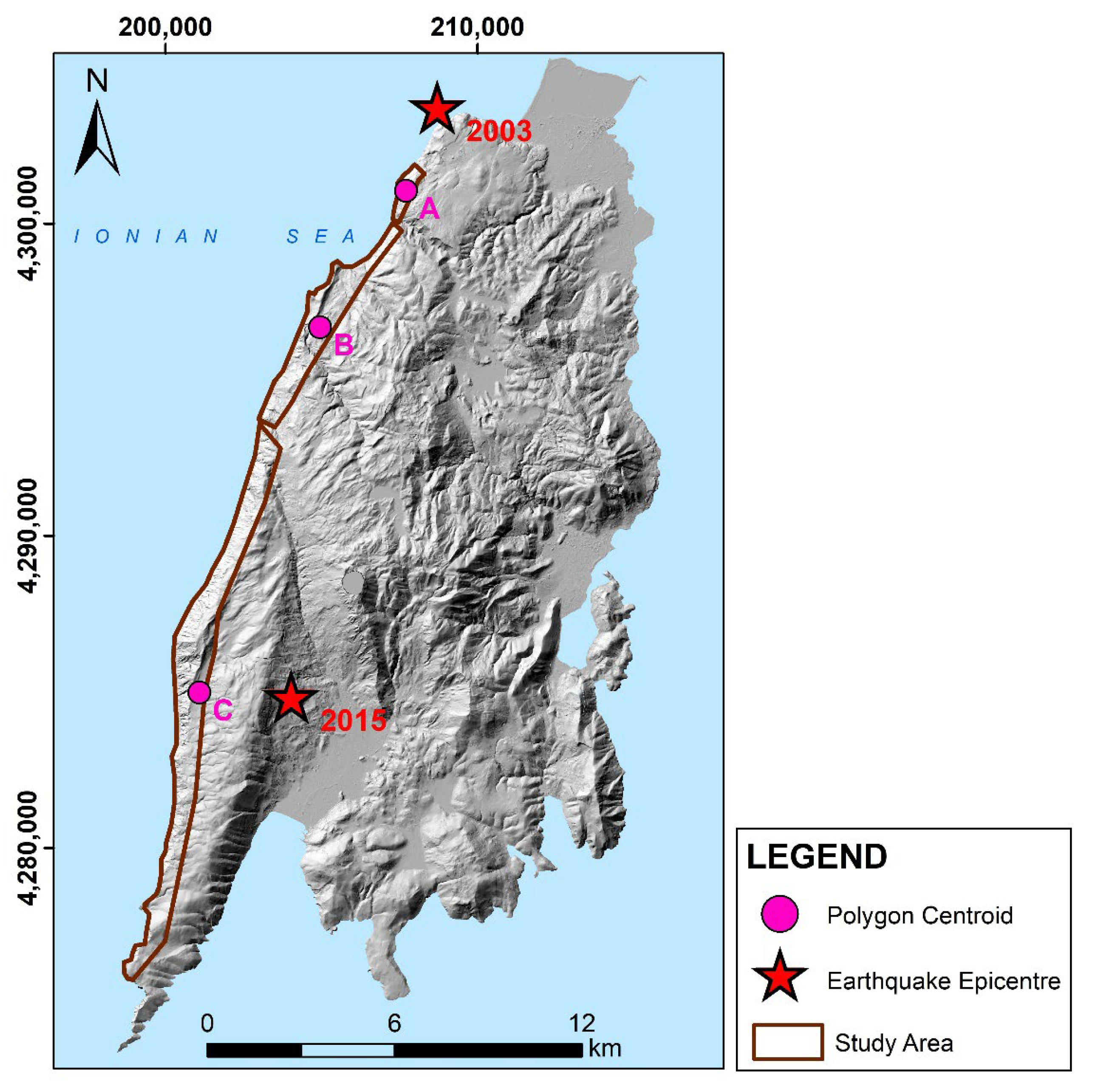
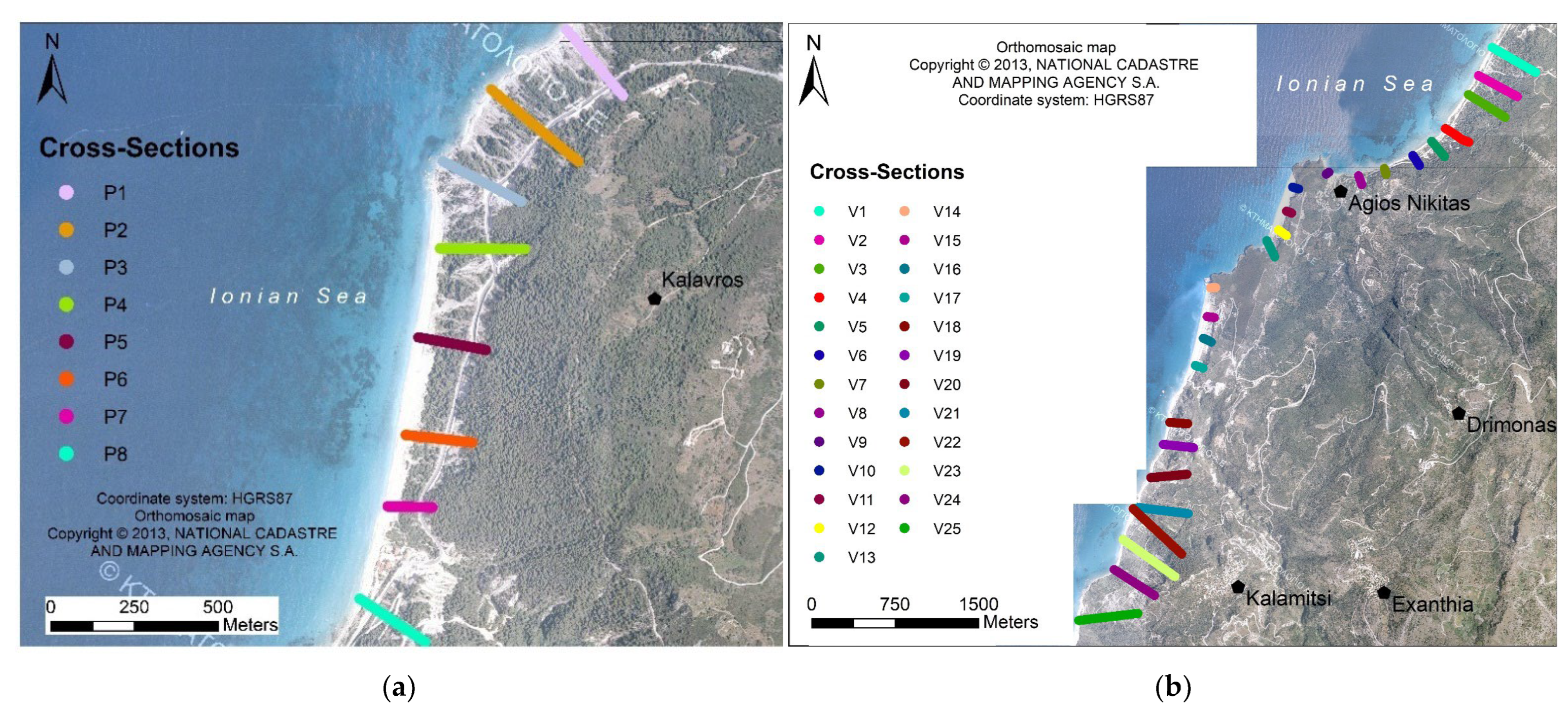
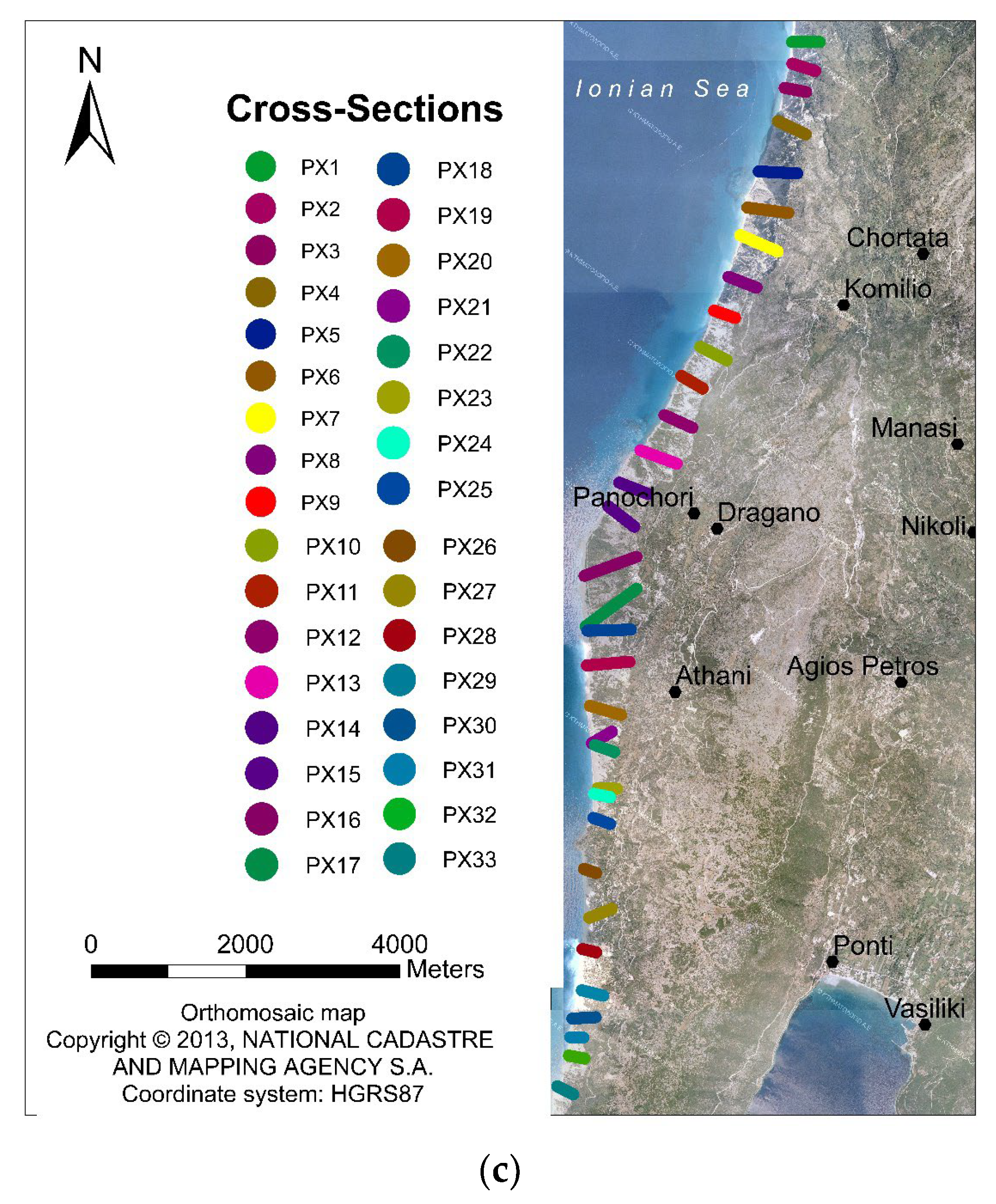
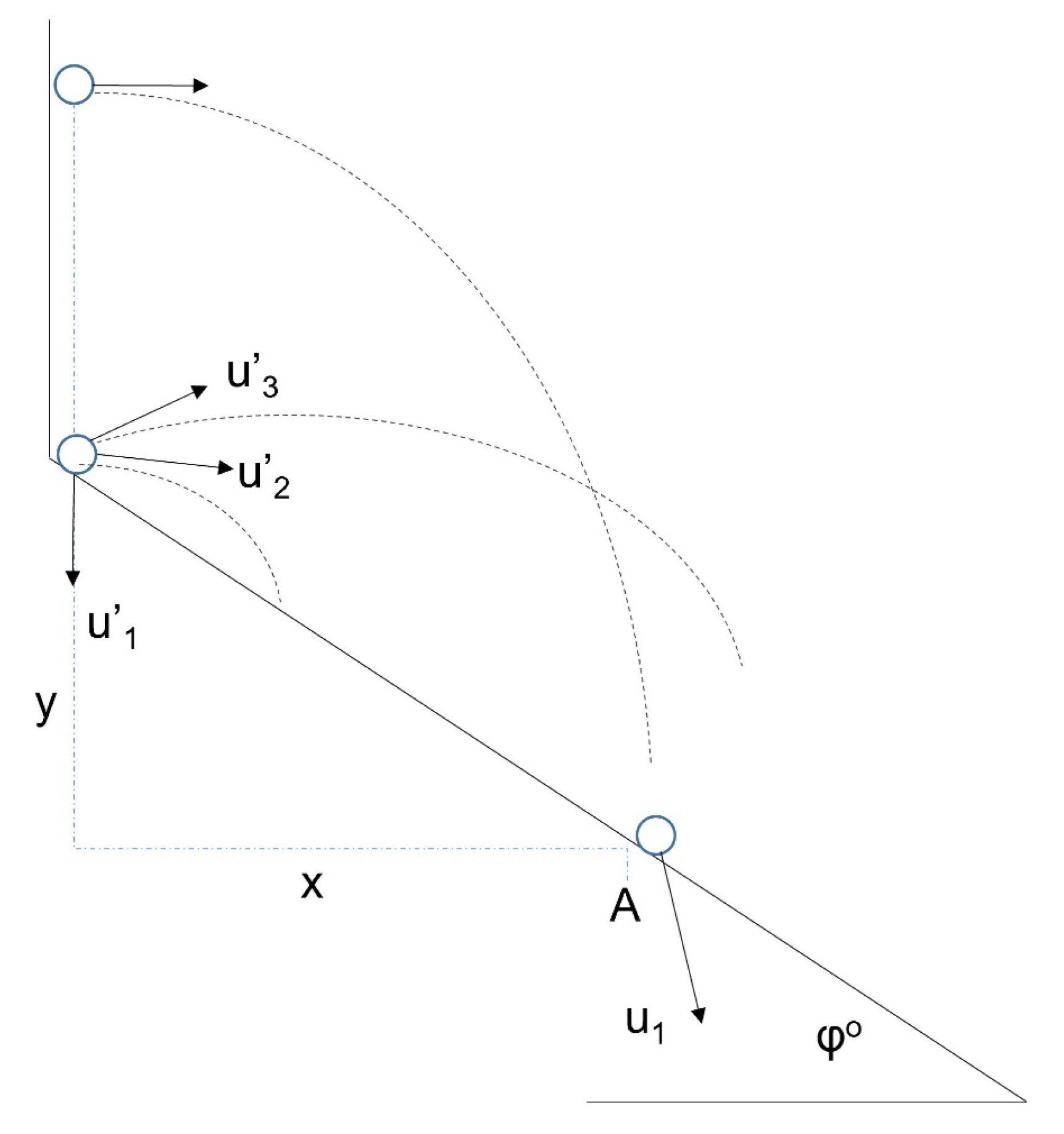

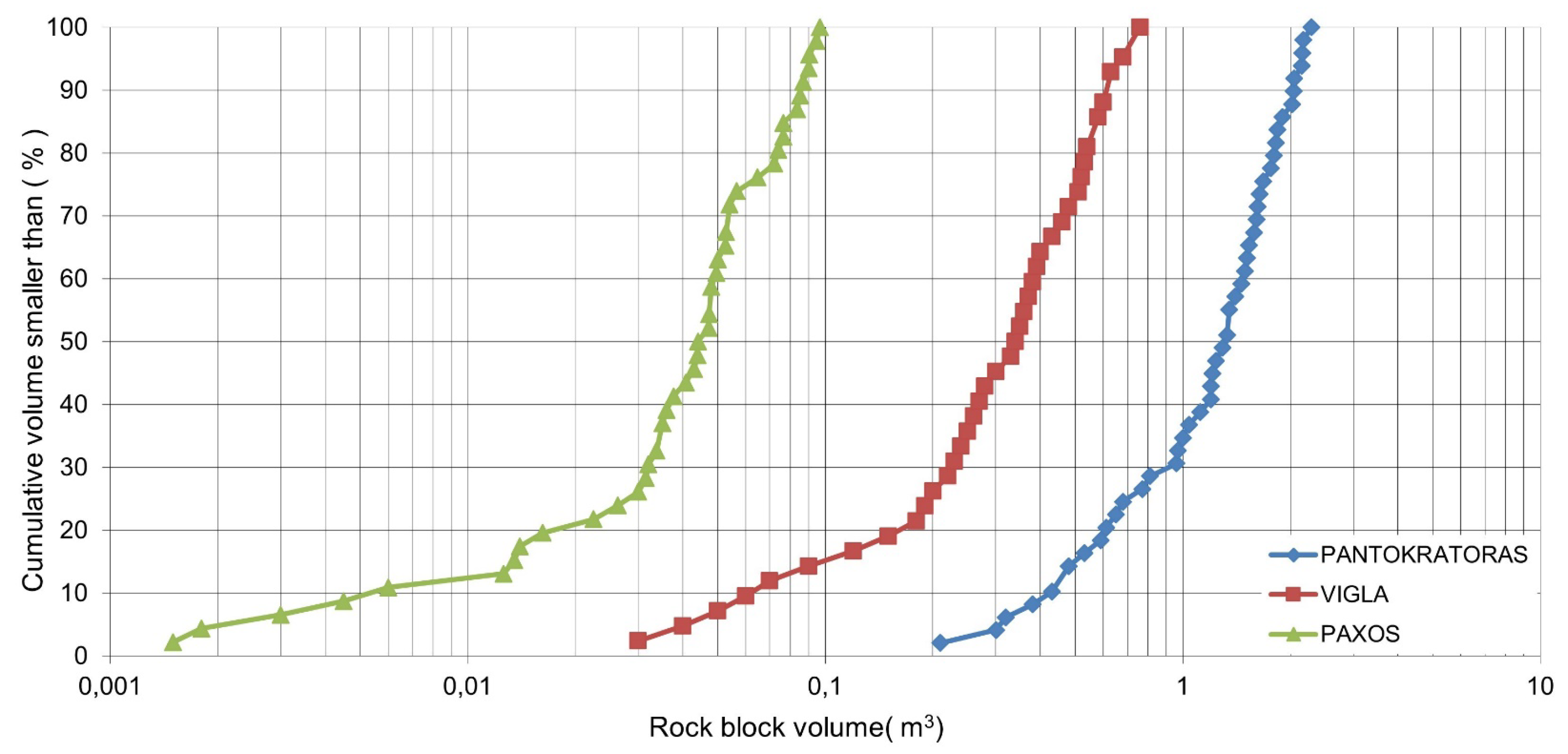

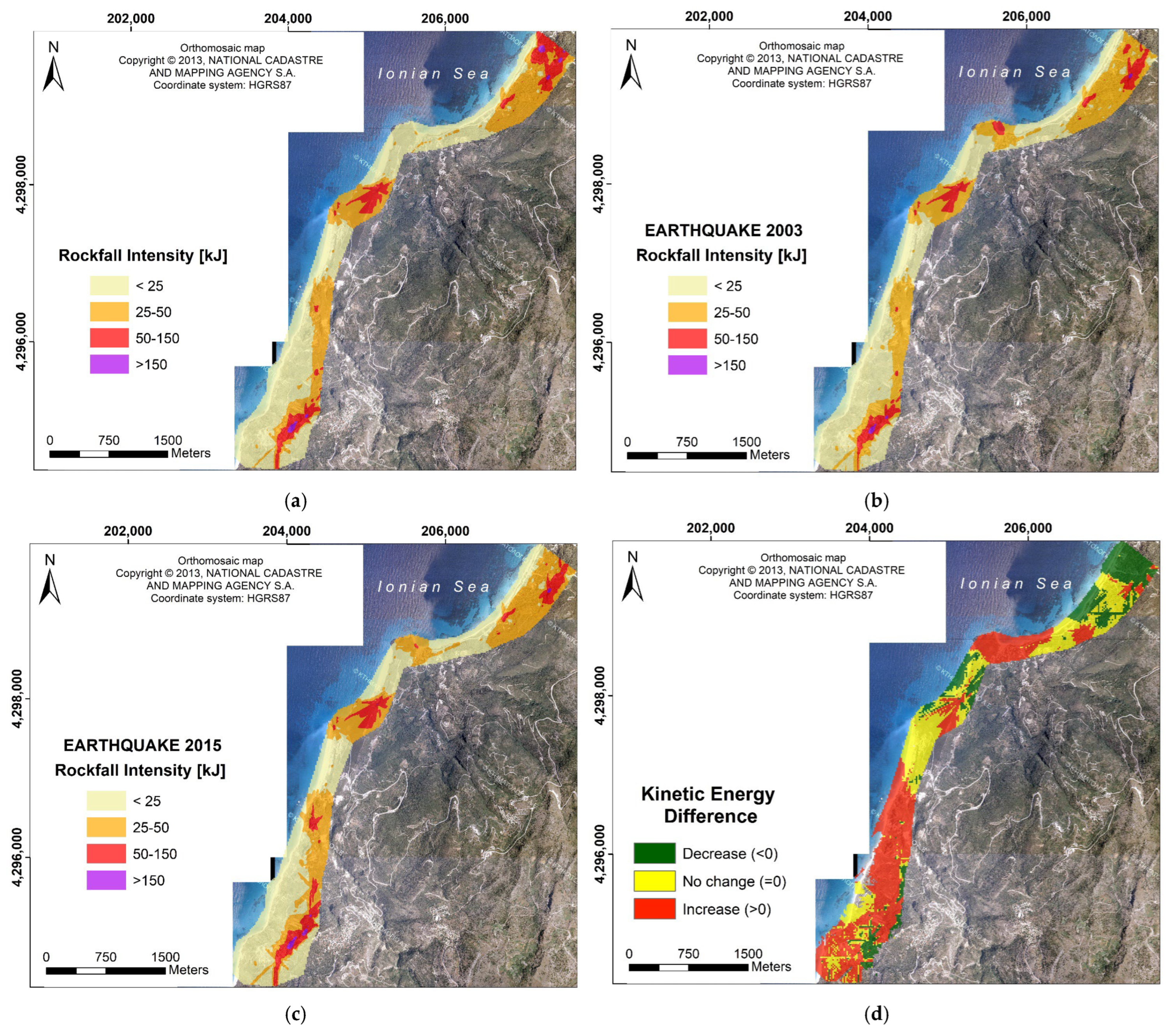
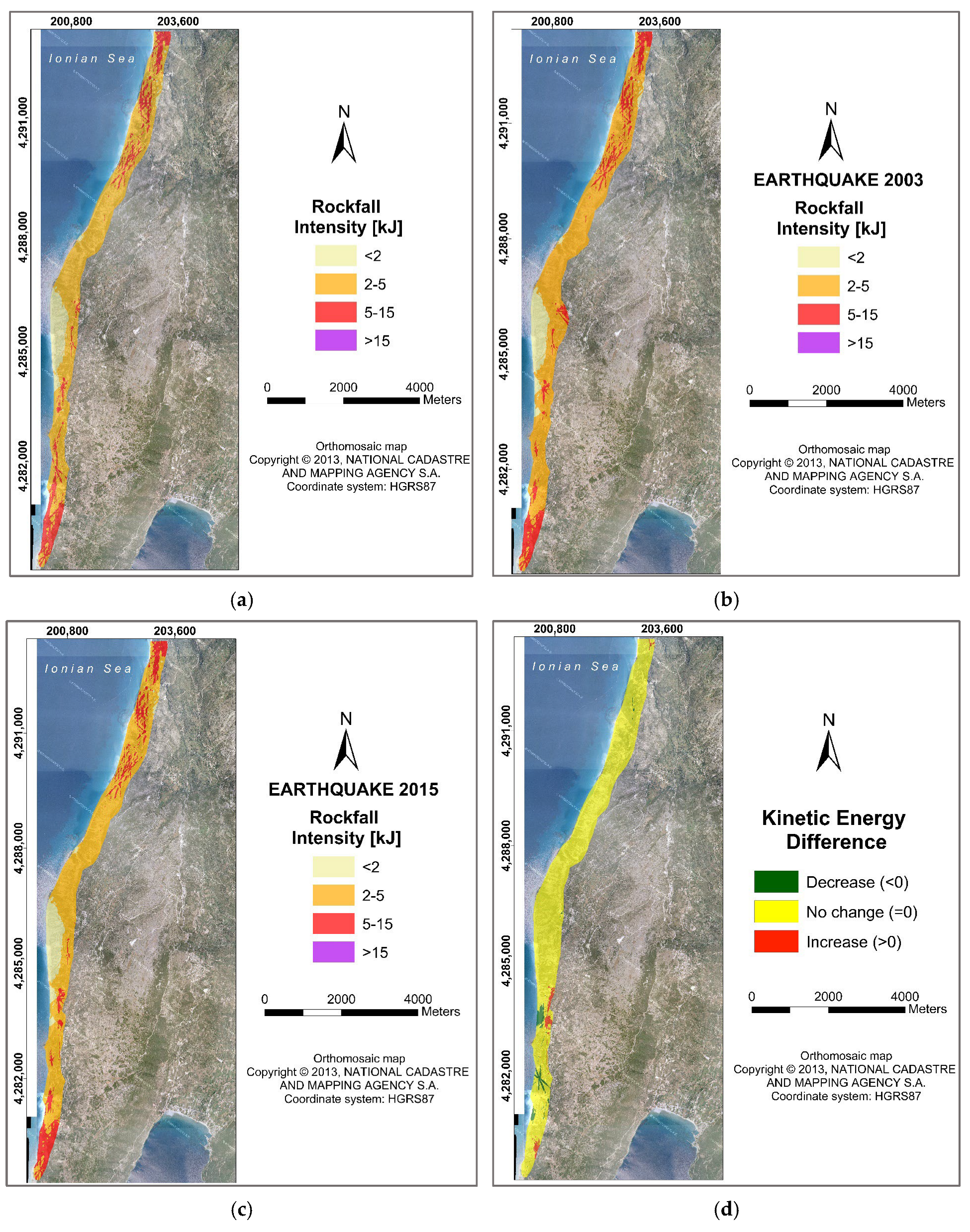
| Limestone Type | Sm-geom 1 (m) | Jv 2 (J/m3) | JRC 3 | JCS 4 (MPa) | GSI 5 | SMR 6 | Vcalc1 7 (m3) | Vcalc2 8 (m3) | Vinsitu 9 (m3) |
|---|---|---|---|---|---|---|---|---|---|
| Pantokratoras | 0.11–0.18 | 22–34 | 10–12 | 170 ± 50 | 35–40 | <20–48 | 0.0025 | 0.0004 | 1.26 |
| Vigla | 0.10–0.15 | 29–32 | 8–12 | 95 ± 40 | 30–55 | 36–42 | 0.0011 | 0.0007 | 0.35 |
| Paxos | 0.08–0.10 | 32–37 | 6–8 | 63 ± 30 | 20–30 | 32 | 0.0007 | 0.0013 | 0.045 |
| Limestones | Pantokratoras | Vigla | Paxos | |
|---|---|---|---|---|
| Number of samples | 49 | 42 | 46 | |
| Mean | 1.2651 | 0.3559 | 0.04591 | |
| Median | 1.3338 | 0.3637 | 0.04562 | |
| Mode | 0.48 | 0.55 | 0.035 | |
| Std. Deviation | 0.5827 | 0.20 | 0.2698 | |
| Skewness | −0.124 | 0.124 | 0.169 | |
| Std. Error of Skewness | 0.340 | 0.365 | 0.350 | |
| Kyrtosis | −1.042 | −0.838 | −0.761 | |
| Std. Error of Kyrtosis | 0.668 | 0.717 | 0.688 | |
| Minimum | 0.21 | 0.03 | 0.00150 | |
| Maximum | 2.29 | 0.7560 | 0.09675 | |
| Percentiles | 25 | 0.7205 | 0.2161 | 0.0290 |
| 50 | 1.3338 | 0.3637 | 0.0456 | |
| 75 | 1.7175 | 0.5220 | 0.0664 | |
| Slope Description | |||||||||||
|---|---|---|---|---|---|---|---|---|---|---|---|
| Limestones | Bare Limestones | Vegetated Limestones | Talus Cover | Talus with Vegetation | Road | Friction Angle | |||||
| RN | RT | RN | RT | RN | RT | RN | RT | RN | RT | (Degrees) | |
| Pantokratoras | 0.315 | 0.85 | 0.29 | 0.68 | 0.32 | 0.82 | 0.29 | 0.65 | 0.40 | 0.90 | 15 |
| Vigla | 0.296 | 0.75 | 0.26 | 0.65 | 0.32 | 0.82 | 0.29 | 0.65 | 0.40 | 0.90 | 15 |
| Paxos | 0.26 | 0.65 | 0.25 | 0.64 | 0.23 | 0.63 | 0.20 | 0.60 | 0.40 | 0.90 | 15 |
| Earthquake | Magnitude (Mw) | Epicentre Distance A (km) | Epicentre Distance Β (km) | Epicentre Distance C (km) |
|---|---|---|---|---|
| 2003 | 6.2 | 2.87 | 8.00 | 20.25 |
| 2015 | 6.5 | 16.6 | 11.85 | 2.95 |
| Earthquake 2003 | Earthquake 2015 | |||||
|---|---|---|---|---|---|---|
| Area | PGVb1 (m/s) | PGVb + SD2 (m/s) | PGVcr3 (m/s) | PGVb (m/s) | PGVb + SD (m/s) | PGVcr (m/s) |
| A | 0.21 | 0.53 | 0.80 | 0.11 | 0.44 | 0.65 |
| B | 0.14 | 0.46 | 0.69 | 0.16 | 0.48 | 0.72 |
| C | 0.06 | 0.38 | 0.57 | 0.46 | 0.79 | 1.18 |
Disclaimer/Publisher’s Note: The statements, opinions and data contained in all publications are solely those of the individual author(s) and contributor(s) and not of MDPI and/or the editor(s). MDPI and/or the editor(s) disclaim responsibility for any injury to people or property resulting from any ideas, methods, instructions or products referred to in the content. |
© 2023 by the authors. Licensee MDPI, Basel, Switzerland. This article is an open access article distributed under the terms and conditions of the Creative Commons Attribution (CC BY) license (https://creativecommons.org/licenses/by/4.0/).
Share and Cite
Servou, A.; Vagenas, N.; Depountis, N.; Roumelioti, Z.; Sokos, E.; Sabatakakis, N. Rockfall Intensity under Seismic and Aseismic Conditions: The Case of Lefkada Island, Greece. Land 2023, 12, 172. https://doi.org/10.3390/land12010172
Servou A, Vagenas N, Depountis N, Roumelioti Z, Sokos E, Sabatakakis N. Rockfall Intensity under Seismic and Aseismic Conditions: The Case of Lefkada Island, Greece. Land. 2023; 12(1):172. https://doi.org/10.3390/land12010172
Chicago/Turabian StyleServou, Aikaterini, Nikolaos Vagenas, Nikolaos Depountis, Zafeiria Roumelioti, Efthimios Sokos, and Nikolaos Sabatakakis. 2023. "Rockfall Intensity under Seismic and Aseismic Conditions: The Case of Lefkada Island, Greece" Land 12, no. 1: 172. https://doi.org/10.3390/land12010172
APA StyleServou, A., Vagenas, N., Depountis, N., Roumelioti, Z., Sokos, E., & Sabatakakis, N. (2023). Rockfall Intensity under Seismic and Aseismic Conditions: The Case of Lefkada Island, Greece. Land, 12(1), 172. https://doi.org/10.3390/land12010172









